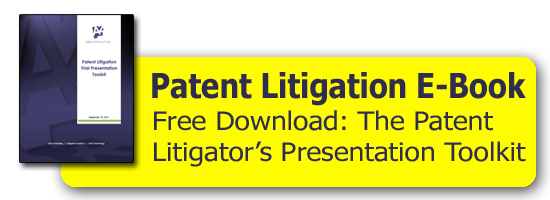As the Washington Business Journal recently wrote, the International Trade Commission (ITC), once an obscure federal agency, has become the epicenter of high-end international patent law in recent years. Its docket is rapidly growing, and its cases can be worth sums in the hundreds of millions or billions of dollars.
And all its trials occur in a nondescript federal building in Southwest Washington, D.C., not far from our Washington, DC headquarters.
A holder of a U.S. patent typically files a case at the ITC in order to block an allegedly infringing product from being imported into the United States. The ITC cases are used as an alternative to or in conjunction with patent litigation. These cases are filed under Section 337 of the Tariff Act, which prohibits unfair competition in imports into the United States. There are no juries, but it remains extremely important to capture and hold the attention of the judge.
We have been very active in preparing exhibits for use in Section 337 cases at the ITC. For example, we developed this PowerPoint presentation to show the nature of a patent for a ground fault interrupter.
In some ways, ITC work is a world unto itself – one that requires a specialized knowledge of the court and of its predilections.
Jim Adduci, an experienced ITC practitioner and managing partner of well-known D.C. international trade law firm Adduci, Mastriani & Schaumberg LLP, says, “At the ITC under Section 337, it’s due process with dispatch. Final decisions in just over a year, and an automatic injunction if you win, explain why the ITC docket has nearly tripled in recent years. Patent-savvy judges and consistent, well-reasoned decisions by the commission itself make the ITC the forum of choice for international patent-based trade disputes.”
Michael Oblon, a partner at Perkins Coie and a past client of ours, says, “When representing a respondent in a multi-party investigation at the ITC, it is critically important to have effective visual presentation materials that enable the administrative law judge to easily discern how your client's devices differ from those of the other co-respondents. I have had great success by using visuals that capture the ALJ's attention while quickly and accurately conveying the facts needed to make my case.”
Blaney Harper, a partner at Jones Day and also a past client, says, “The key at the ITC is to know your judge. You've got to get his or her attention and focus the judge as quickly as possible on the main issues that you need to win. This is especially true on cross-examination with regard to demonstrative evidence. If you bore the judge, the issue you care about may be missed.”
Andrew Thomases, a partner at Skadden, Arps, Slate, Meagher & Flom and another past client, agrees. “Presenting at the ITC requires a fast-paced judge-focused presentation. Since the issues we typically present are complex and technical in nature, use of compelling visual presentations help the judges quickly process the key information in a case,” Thomases says.
While ADR in all forms is common and increasing in frequency, so too are proceedings at the World Bank, the ICC, the FTC and the ITC. In each of these venues, costs of litigation are generally lower than a district court proceeding, rules are somewhat more liberal and they offer a legal playing field that favors high-caliber litigators.
With the passage of patent reform, new ALJ-led patent review proceedings at the PTO will likely require similar litigation skills and tactics to those of the ITC. As these judicial proceedings supplant some patent court cases, patent litigators must be prepared for faster and more efficient presentations.
To learn more about patent litigation trial presentation, we suggest downloading our free ebook on the topic.
To learn 5 Ways to Research Your Judge's Likes and Dislikes, click here.





Leave a Comment